This page is on the Internet at http://www.mmdtkw.org/GR-Unit5--GreekDarkAge.html

Ancient Greece 1
Unit 5 -- Greek Dark Age ca. 1100s-800s BC
From https://en.wikipedia.org/wiki/Greek_Dark_Ages
Archaeological evidence shows a widespread collapse of
Bronze Age civilization in the eastern Mediterranean world
at the outset of the period, as the great palaces and cities
of the Mycenaeans were destroyed or abandoned. Around this
time, the Hittite civilization suffered serious disruption
and cities from Troy to Gaza were destroyed. Following the
collapse, fewer and smaller settlements suggest famine and
depopulation. In Greece the Linear B writing of the Greek
language used by Mycenaean bureaucrats ceased. The
decoration on Greek pottery after ca 1100 BC lacks the
figurative decoration of Mycenaean ware and is restricted to
simpler, generally geometric styles (1000–700 BC). It was
previously thought that all contact was lost between
mainland Hellenes and foreign powers during this period,
yielding little cultural progress or growth; however,
artifacts from excavations at Lefkandi on the Lelantine
Plain in Euboea show that significant cultural and trade
links with the east, particularly the Levant coast,
developed from c. 900 BC onwards, and evidence has emerged
of the new presence of Hellenes in sub-Mycenaean Cyprus and
on the Syrian coast at Al Mina.
From http://ancient-greece.org/history/dark-ages.html
During the Dark Ages of Greece the old major settlements
were abandoned (with the notable exception of Athens), and
the population dropped dramatically in numbers. Within these
three hundred years, the people of Greece lived in small
groups that moved constantly in accordance with their new
pastoral lifestyle and livestock needs, while they left no
written record behind leading to the conclusion that they
were illiterate. Later in the Dark Ages (between 950 and 750
BC), Greeks relearned how to write once again, but this time
instead of using the Linear B script used by the Mycenaeans,
they adopted the alphabet used by the Phoenicians
“innovating in a fundamental way by introducing vowels as
letters. The Greek version of the alphabet eventually formed
the base of the alphabet used for English today.”
From http://www.ancient.eu/Greek_Dark_Age/
The Greek Dark Age is the interval between the collapse of
the Mycenaean civilization, around 1200 BC, and the Greek
Archaic Period, around c. 800 BC. The Dark Age era begins
with a catastrophic event: the collapse of the Mycenaean
civilization, when all major Mycenaean regional centres fell
out of use after suffering a combination of destruction and
abandonment. Linear B script, the Mycenaean writing system,
was lost shortly after c. 1200 BC; for this reason, we have
no first-hand written documents of any kind for this period.
Thus, our understanding of the Greek Dark Age relies largely
on archaeological research.
Click on small images to see larger versions
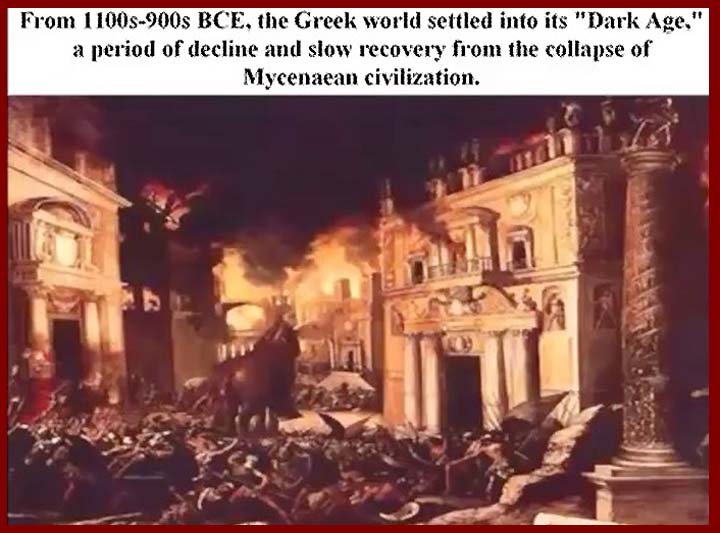
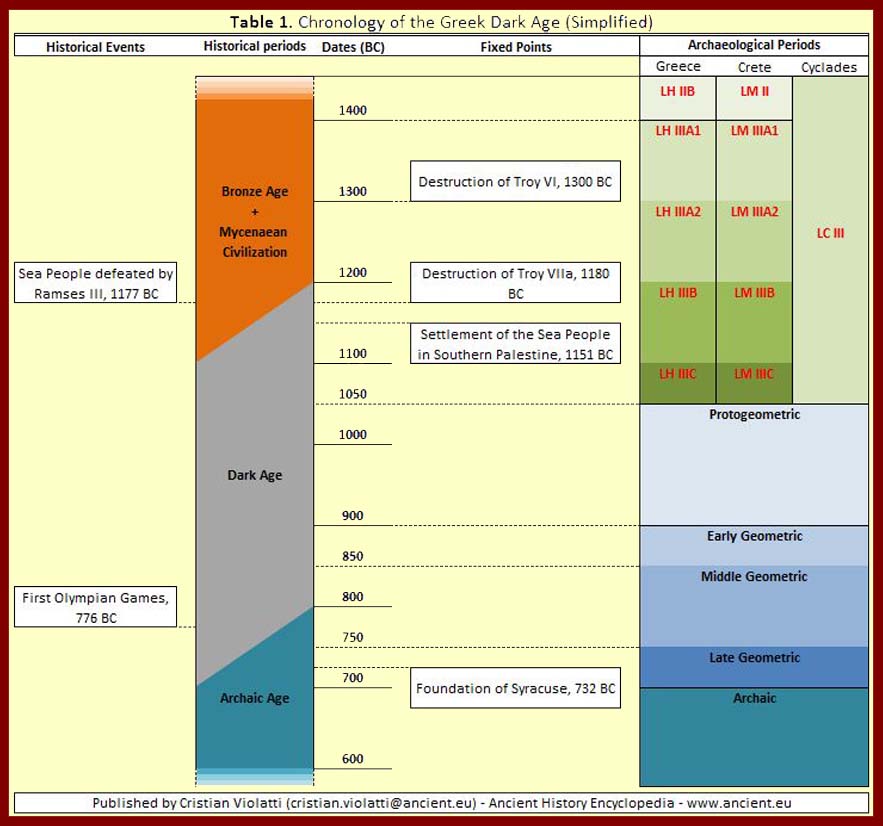
The causes of the general collapse of Bronze
Age civilizations around the eastern end of the
Mediterranean remain a mystery. The image shows a
burning city, and some cities do, indeed, have burn levels
at about the right time. But not all do, and,
nonetheless, those cities without burn levels, destruction
levels, or other evidence of conflict still collapsed.
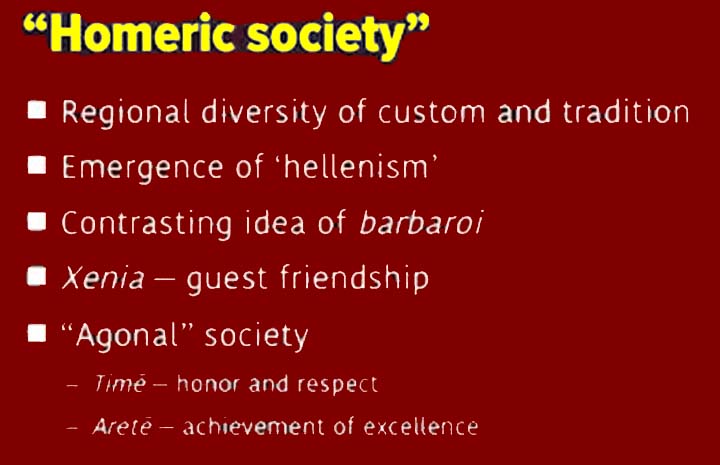
It is now assumed that theTrojan War (or wars) really did
occur. It's not so clear that any of the events
described by Homer took place exactly as he said they
did. It's an extreme stretch to think that any gods or
goddesses intervened. The Mycenaean did establish
colonies on the Anatolian coast, and it's inevitable that
they had unfriendly (at least) interactions with the
Hittites, who claimed hegemony in the Area. Troy (what
the Hittites called Wilusa (Greek Ilios)) was an Eastern
Anatolian Hittite dependency.
Homer's Iliad, undoubtedly drawn from earlier oral
traditions, can be read as a report of how Mycenaean
(Achaean = Ahhawiya in Hittite) behaved - badly - when
invading foreign territory and how they justified their
actions.
It's also fairly certain that the Mycenaeans, or at least
Mycenaean refugees after the fall of Mycenaean Greek
mainland cities, formed a component of the eastern
Mediterranean invaders that came to be called the "Sea
Peoples" in recent modern times.
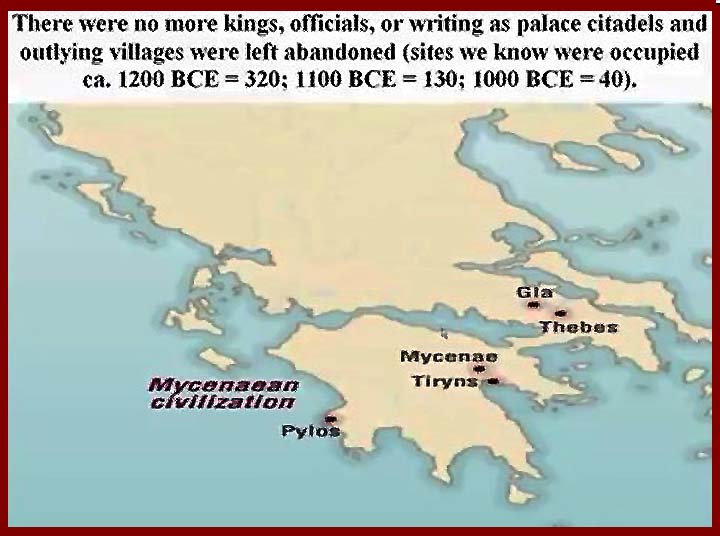
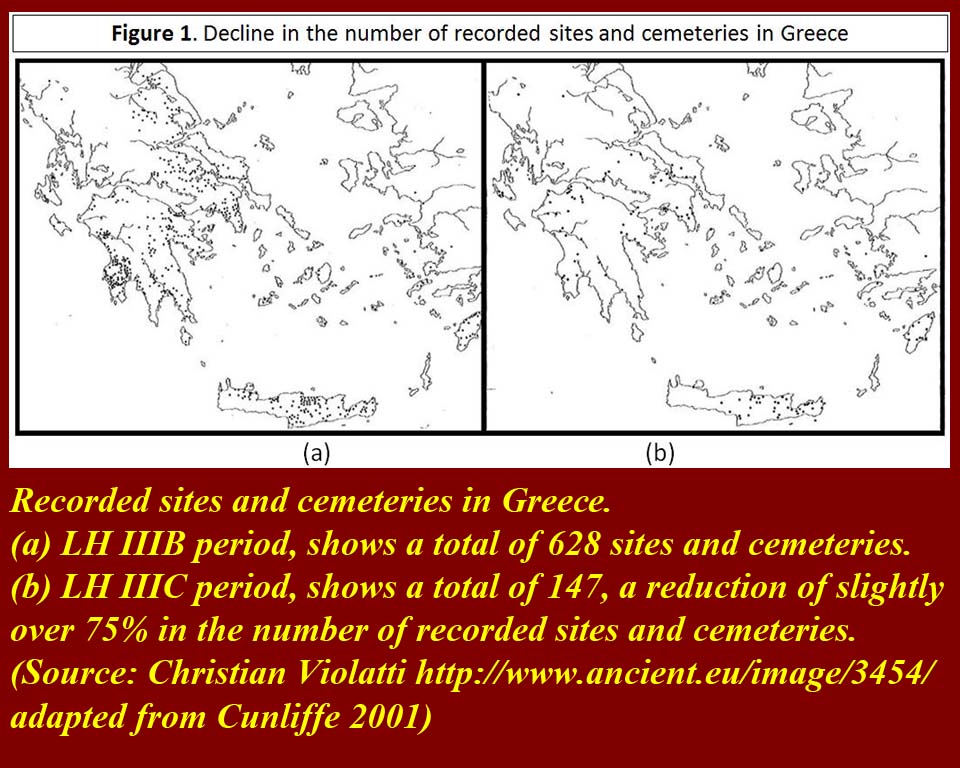
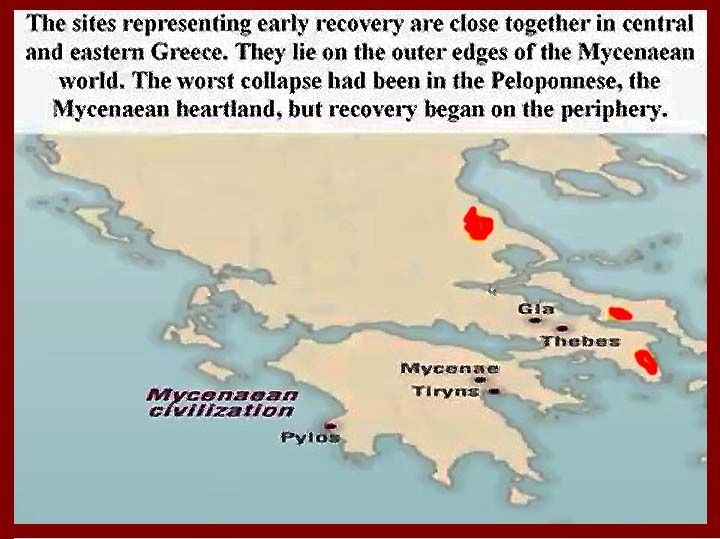
The Dark Age is the gap between the end of the Greek Bronze
Age and the point when the recovery had reached the point
that writing was reestablished, and that meant that
the Mycenaeans who headed east after the fall brought the
use of the Phoenician alphabet back to mainland
Greece. The first known use of the alphabet (and
possibly the reason for bringing it to Greece) was the
writing down of the Epics of Homer and others.
The gap itself was not recorded (no writing with which to
record it), but archeological evidence is clear.
Population declined, settlement sites were abandoned,
cemeteries went out of use.
When recovery began, it was at the periphery of the old
inhabited are.
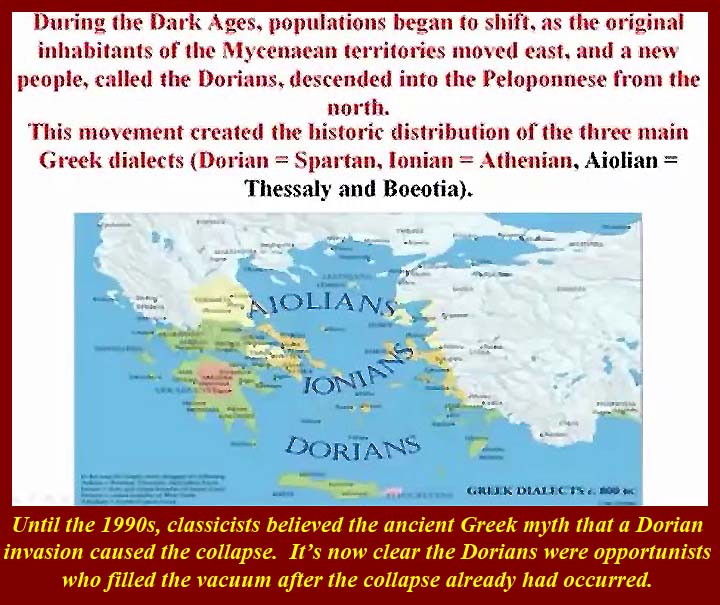
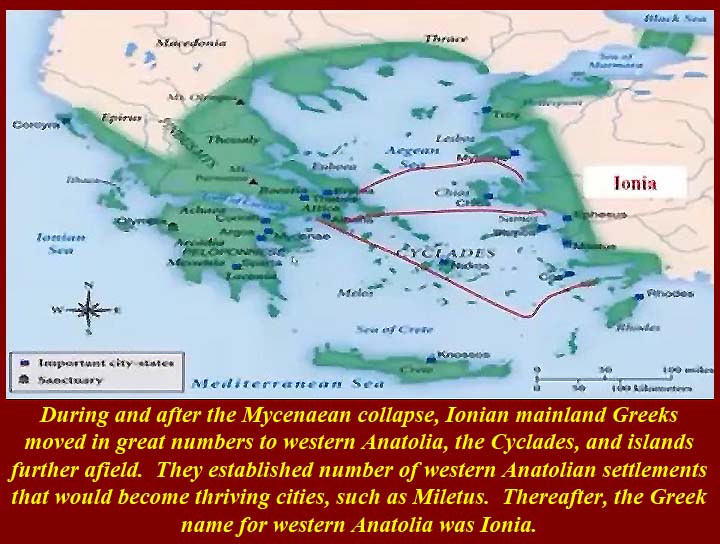
Populations moved during the Dark Age. Groups later
known as "Dorians" moved southward inside Greece during the
11th and 10th centuries and either reoccupied vacant sites
of established new settlements. Some "Ionians"
moved to the west coast of Anatolia and further afield (as
Sea Peoples?). Eventually, western
Anatolia became known as Ionia among later Greeks.
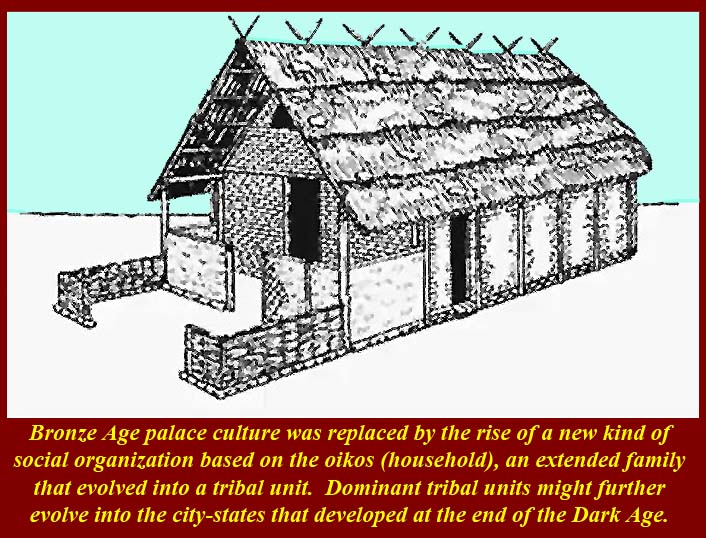
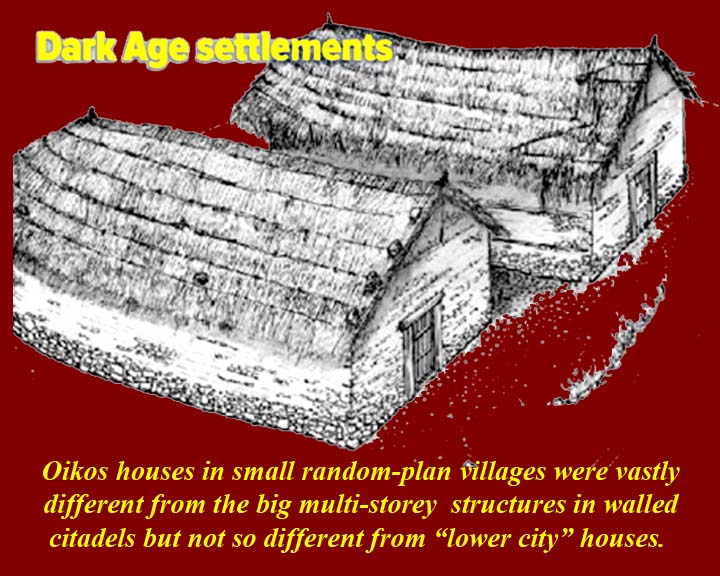
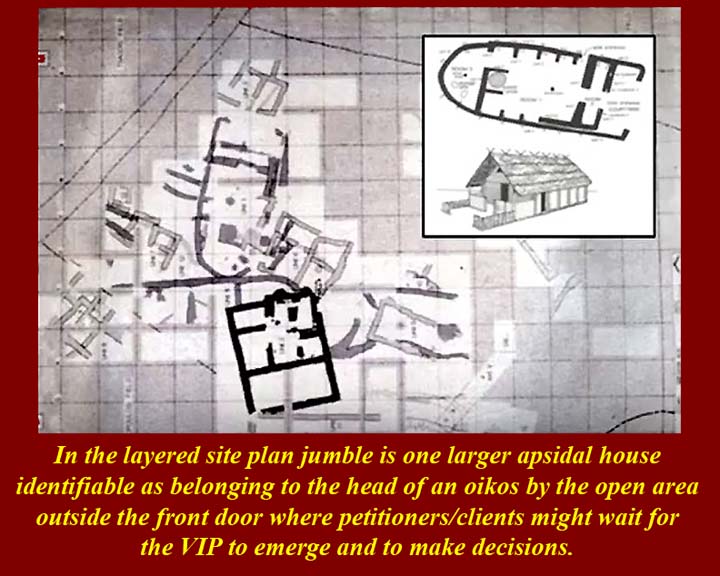
Palace culture was gone and a new model, based on the Oikos
or extended family, developed. Extended families
evolved int a tribal system when families grouped together
for protection. Strong men emerged, and groups moved
to high ground for protection. The houses of the
chieftains often had open spaces where client-petitioners
could assemble. These open spaces eventually became
the agoras of city states, poleis.
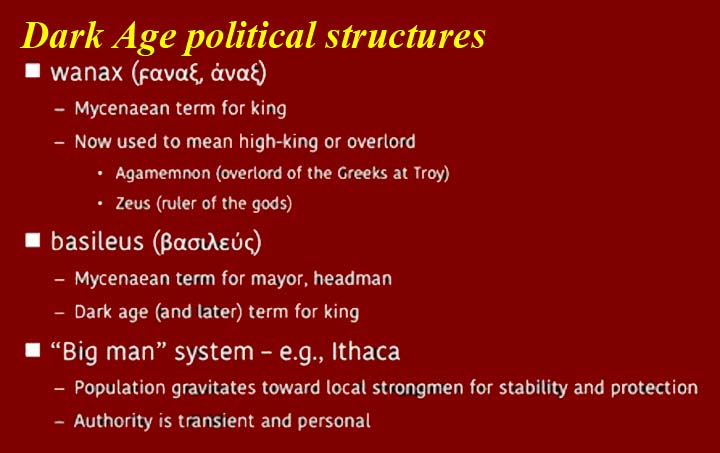
Political developments in the course of the Dark Age as the
Bronze Age wanax was replaced in the leadership role
by the local basileus, the king or strongman
of a city state. (Note that translating these
Basileus/strongmen as "kings" is a product of German
translators, who were themselves subjects of Kings.
Americans, if asked, might have called them political
"Machine Bosses".)
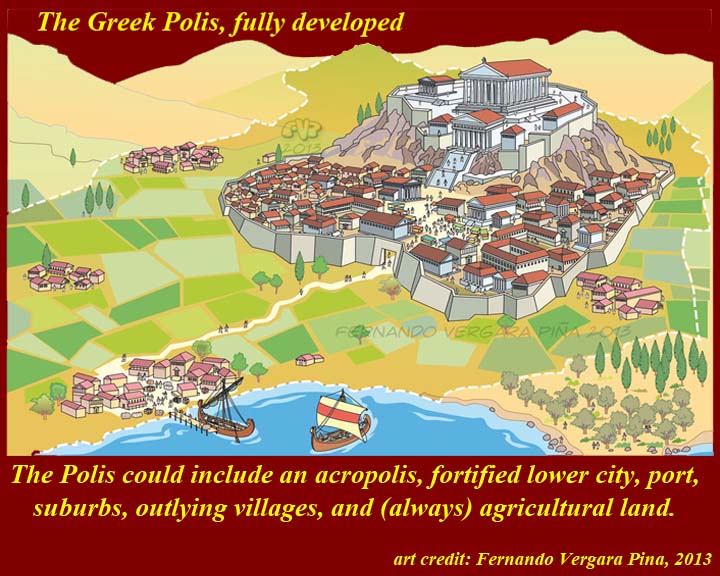
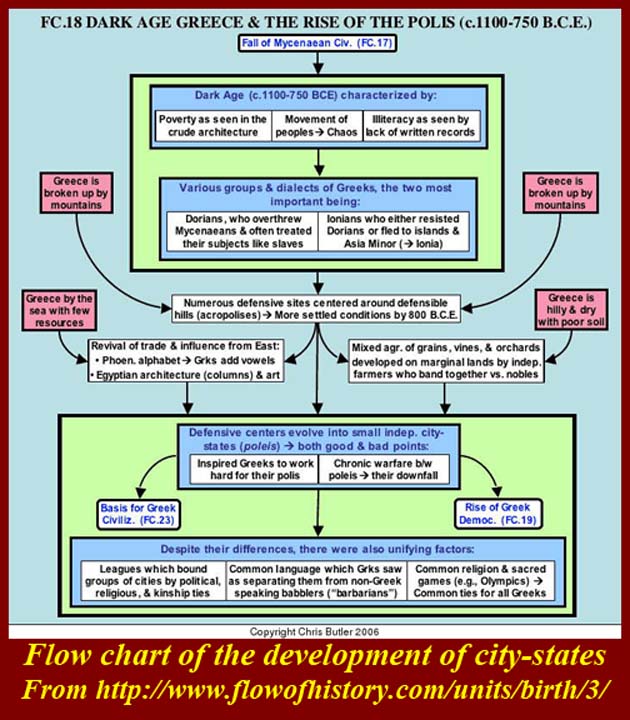
Emerging from the Dark Age were poleis --
city-states -- ruled by basileis -- kings or
"machine bosses".
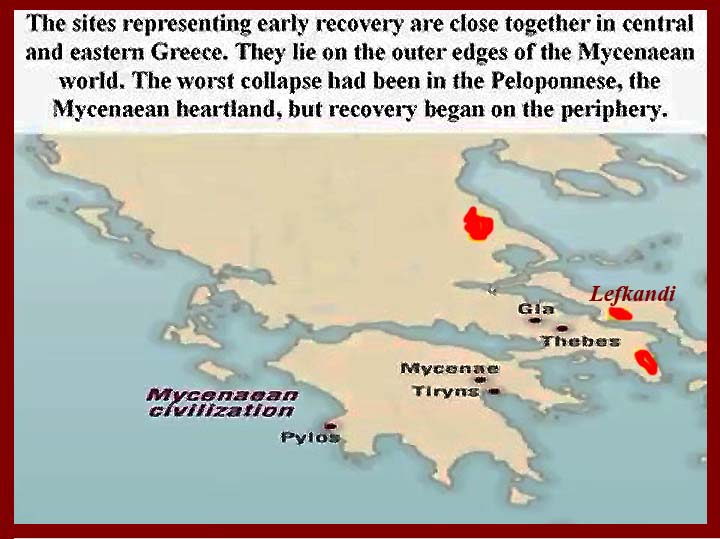
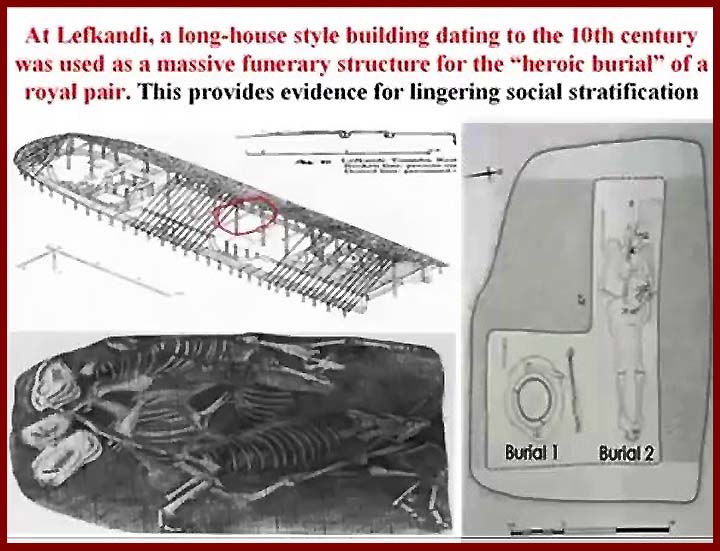
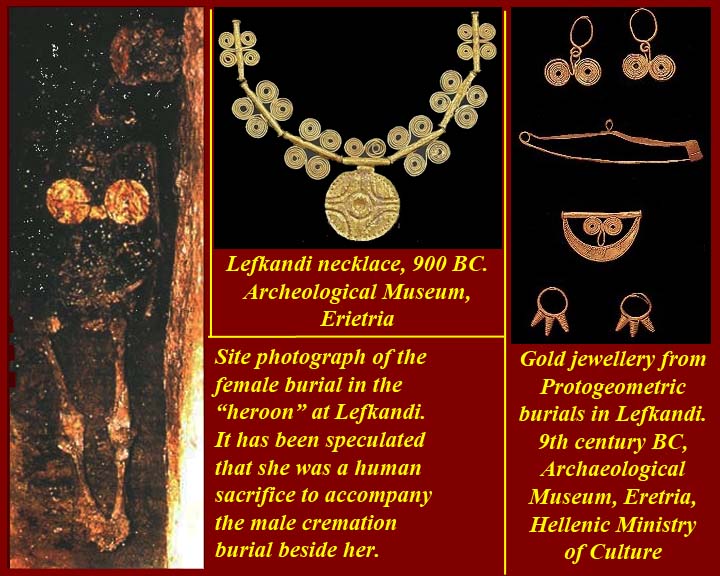
One of the peripheral sites that rapidly redeveloped was
Lefkandi on Euboea, a large island off the east coast of
mainland Greece. Finds on the Island indicate that contact
with the east was reduced but not really lost as it had been
with most sites on the mainland. Lefkandi's most
important dig is the "heroon" or heroic burial in the
center of a large oikos house. After the
burial, the whole house was filled and mounded over.
The burial consisted of a cremated male flanked by an
inhumed female. Two horses were also buried, and it
has been suggested that the woman and the horses were
sacrificed to accompany the dead man. More on the
Lefkandi burial later -- Lefkandi is mentioned here only as
an example of early recovery in the Dark Age. Other
settlements redeveloped (or developed from rural
settlements) later.
Athens was an exception, because it apparently was not fully
depopulated in the general collapse, although it did suffer
cultural losses including the loss of writing. The
inhabitants who remained in Athens were sometimes called
Pelasgians by later Greeks, although that term is now
usually applied to pre-Greek-speaking indigenes of the
Aegean area. Classical Greeks appear to have used the
term more broadly to mean "earlier people" or folks before
the Dark Age.
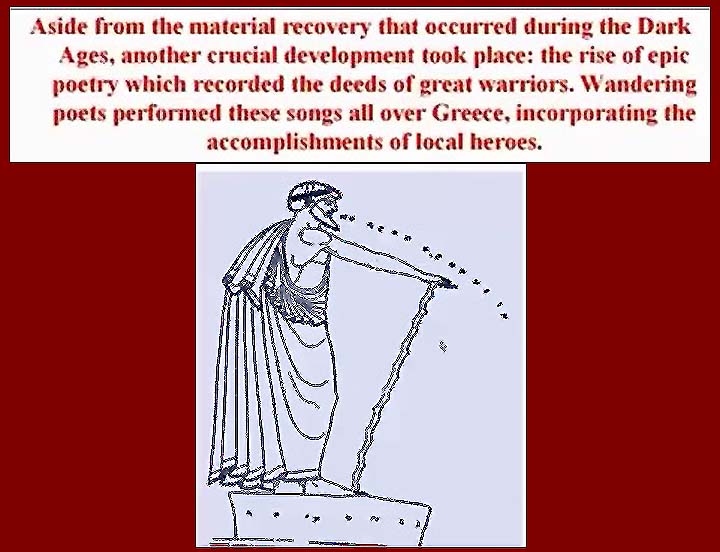
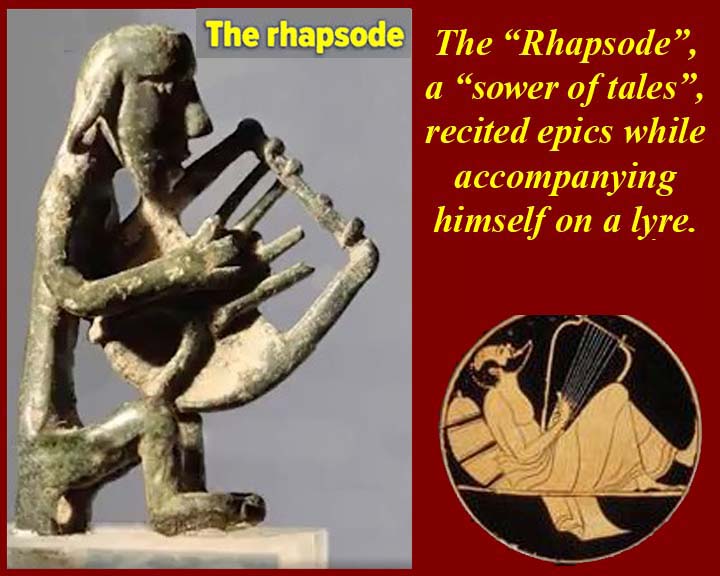
Recitation of "epics" may have been a feature of court life
before the dark age. It is thought that recitation of
what became the Homeric Epics and the other heroic epics of
the Epic Cycle that filled out the Trojan War prelude,
story, and postlude started very early and perhaps even
contemporaneously with the war. (This is because to preserve
the meter in recitation it is necessary to pronounce the
early Greek "digamma", which was lost in dark age
Greek dialects that were eventually encoded with the
Phoenecian alphabet; to preserve the meter, the "digamma",
usually transliterated as a "w" would have been pronounced
as "oo", e.g., what we today read/pronounce as "ilios" would
be pronounced as "oo-ilios" in Homeric Greek).
A singers of the Epics were called "guy (and assuredly
always a guy) who stitched together tales" or in, in Greek,
a ῥαψῳδός (rhapsodos), and if Homer sang his Epics,
rather than just writing them down for other singers and
posterity, he was a rhapsodos.
There may have been other stories in other epics that didn't
make the cut to get to our time. The Homeric Epics and
the Epic Cycle were the best sellers of their day and
continued to be best sellers into Roman times, because the
Julio-Claudian imperial dynasty (Julius Caesar, Augustus,
Tiberius, Caligula, Claudius, and Nero) promoted the
Troy stories. We inherited the Achaeans and Trojans
rather than some othe forgotten (not promoted) tales.
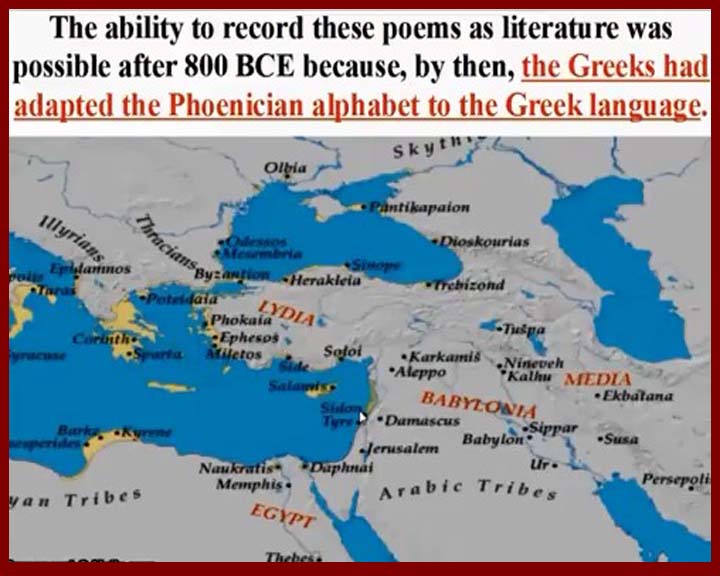
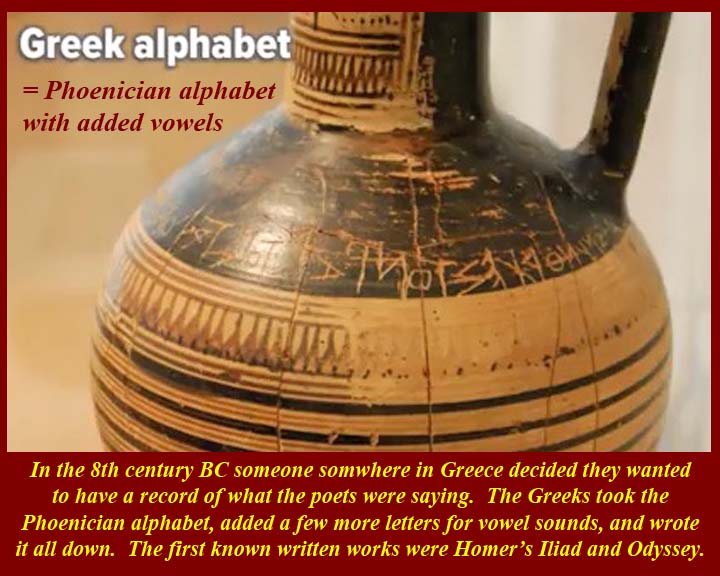
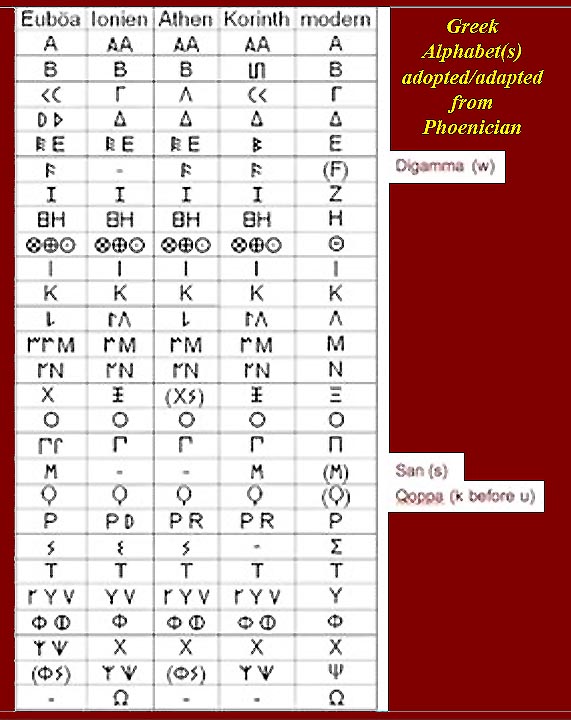
The Greeks of the Dark Age, like many others in the Eastern
Mediterranean, adopted and adapted the Phoenician alphabet
and that allowed them to write down the epics that they so
much appreciated. Different areas of the Greek
speaking world used slightly different versions of the
alphabet, and that served well until larger and larger
groups united.
With only a few exceptions the result is the Greek alphabet
used today. The Romans modified the Greek alphabet to
construct what most of the west uses and what the whole
world can understand -- see the Internet, in which the
"Roman" alphabet (and American-English Language) is
omnipresent. (It can actually be argued that Chinese
and Hindu scripts encode more of the internet than the Roman
script, but, worldwide, the preferred script is Roman.)
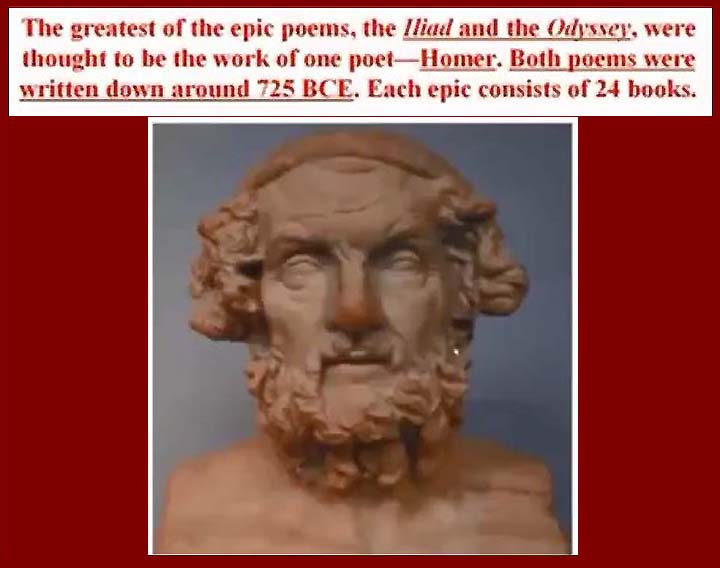
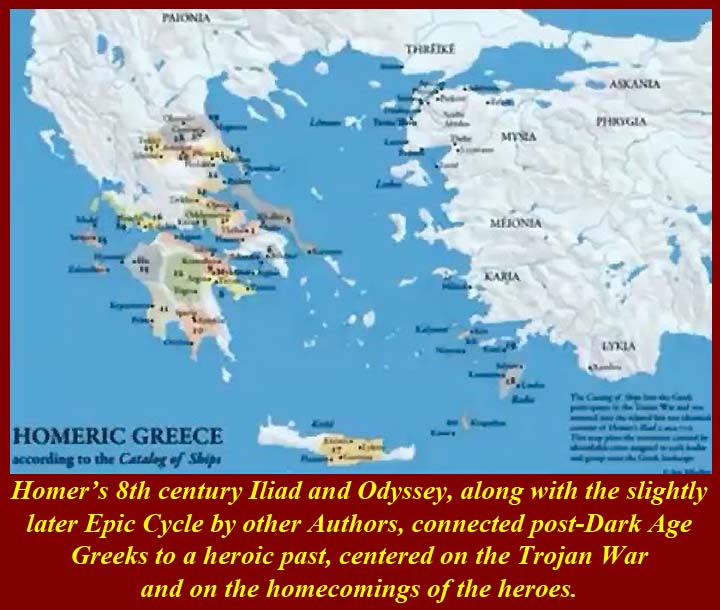
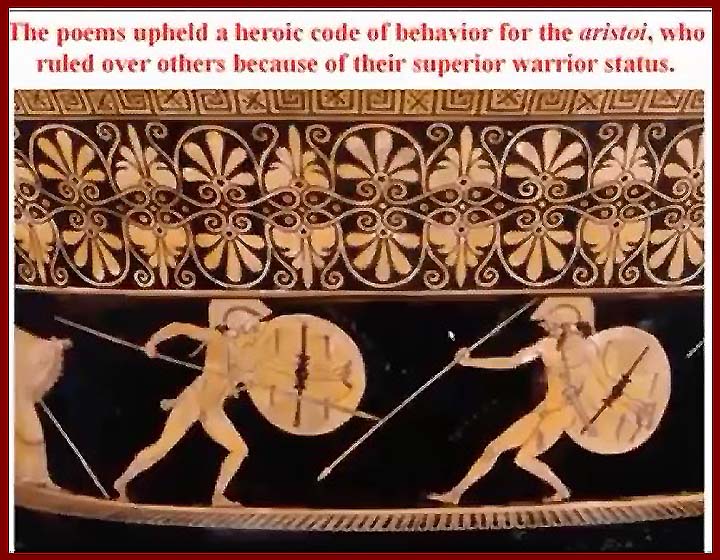
All peoples cherish their own heroic myths, and especially
myths that accommodate and glorify the things that the group
wants to believe about themselves. The Greek Epics
transmitted the heroic code of the aristocrats of the past
and showed that men could compete, at least on the moral
plane with the gods -- or at least it showed that the gods
were at least as petty, untrustworthy, disloyal, unhelpful,
discourteous, cowardly, dirty, and irreverent. (So any
former Boy Scout could tell you that they were just the
opposite of the "Scout Law".) That would in turn
justify just about any dastardly behavior by men and Women
-- you could be just like the gods and goddesses. The
"heroic code" transmitted by the epics in reality was pretty
worthless, but it did let the bosses do what the wanted to
do .
"Might-have-been" epics that didn't reinforce what the power
brokers wanted didn't stand a chance of being
remembered.
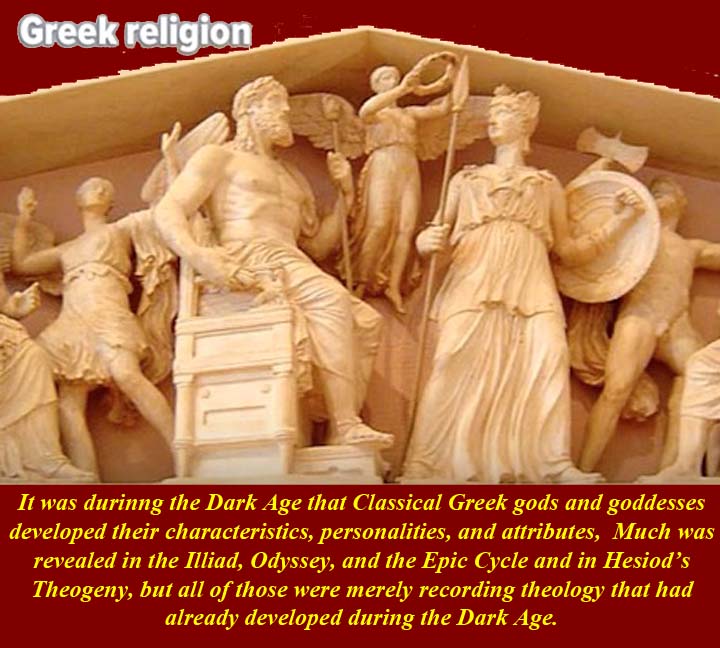
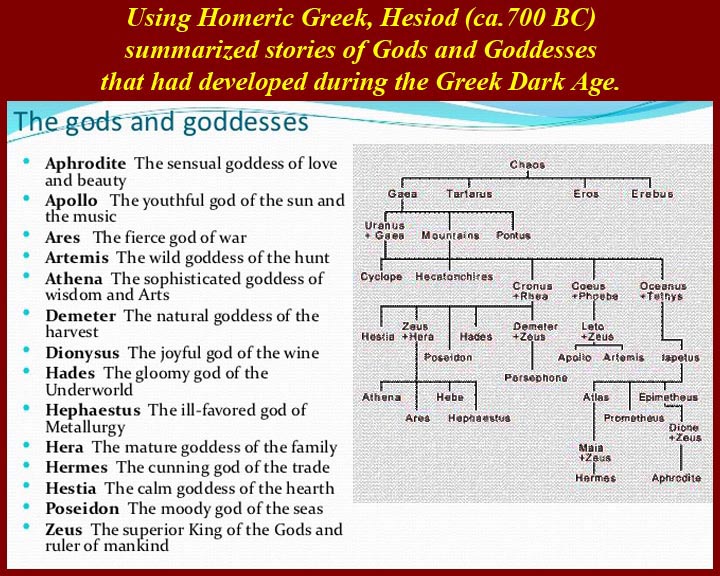
Greek polytheism developed during the dark ages a "seers"
and proto-priests repeated the attributes and action of
pre-fall deities and they added information based on the
acts and personalities of the deities as demonstrated in the
oral epics. After writino was reestablished they wrote
it all down. What has come down to us is the Theogeny
of Hesiod.
From https://en.wikipedia.org/wiki/Hesiod
Hesiod (Greek=Ἡσίοδος Hēsíodos) was a Greek poet generally
thought by scholars to have been active between 750 and 650
BC, around the same time as Homer. His is the first
European poetry in which the poet regards himself as a
topic, an individual with a distinctive role to play.-
Ancient authors credited Hesiod and Homer with establishing
Greek religious customs. Modern scholars refer to
Hesiod as a major source on Greek mythology, farming
techniques, early economic thought (he is sometimes
considered history's first economist), archaic Greek
astronomy and ancient time-keeping.
The Evelyn-White 1914 English translation of the Theogeny is
on the Internet
at http://www.sacred-texts.com/cla/hesiod/theogony.htm.
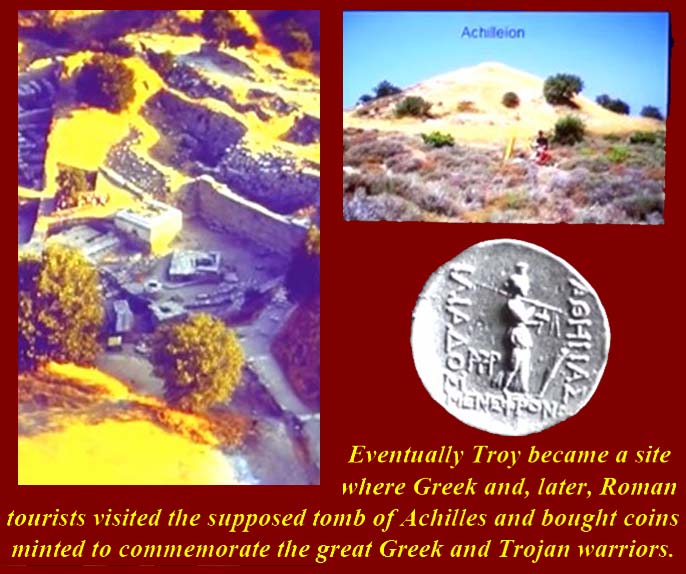
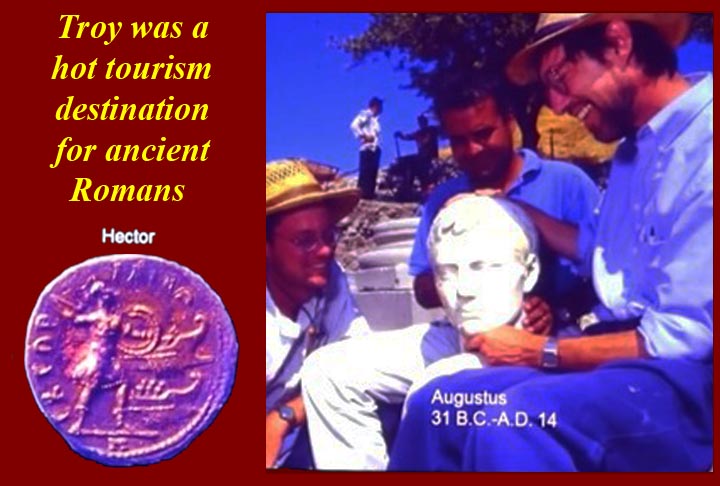
Troy became the touchstone first for post--Dark Age Greeks
(and others) and then for Romans. It became a
pilgrimage site for later leaders, among them Alexander,
Xerxes (a Persian other), Augustus, Hadrian among the
ancients. Commoners visited and still do and take home
(still) commemorative coins minted for the purpose.
Developments during the Dark Age
Geometric art
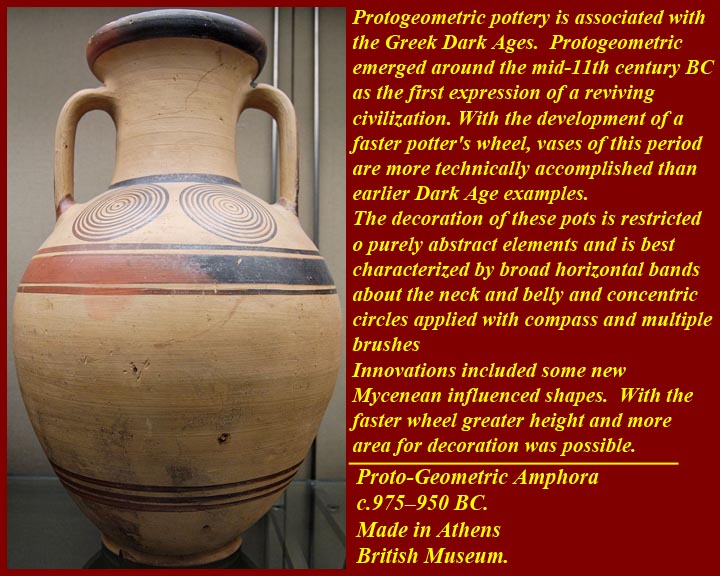
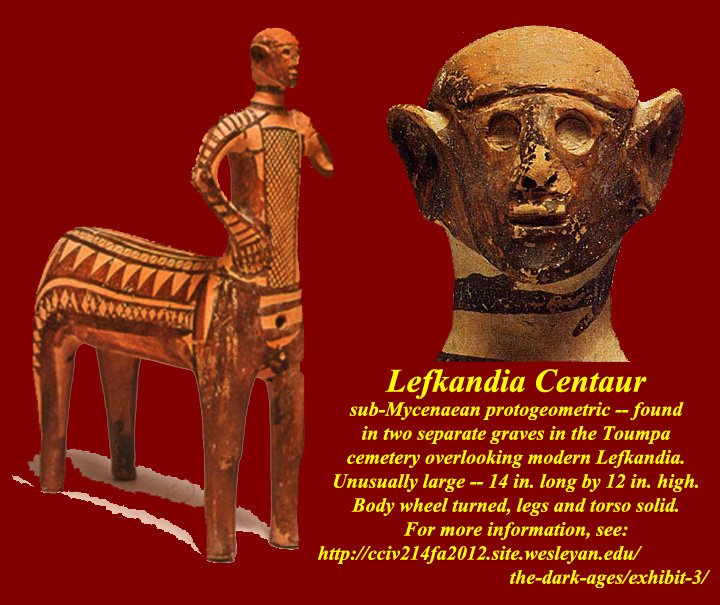
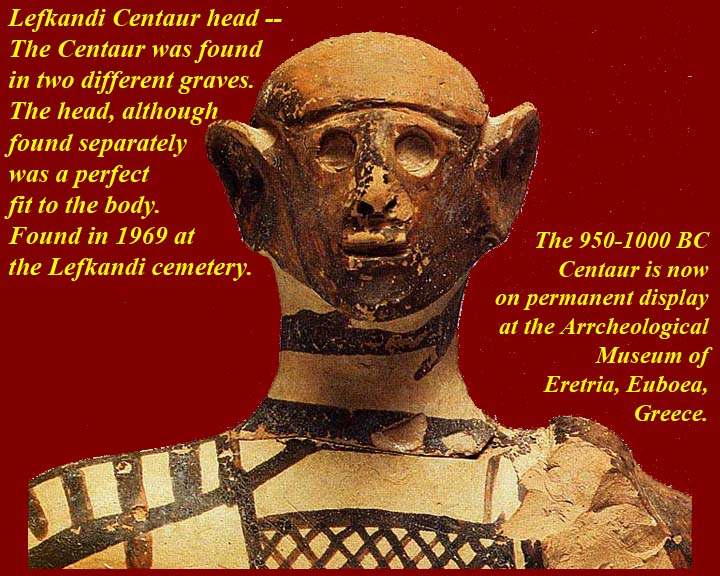
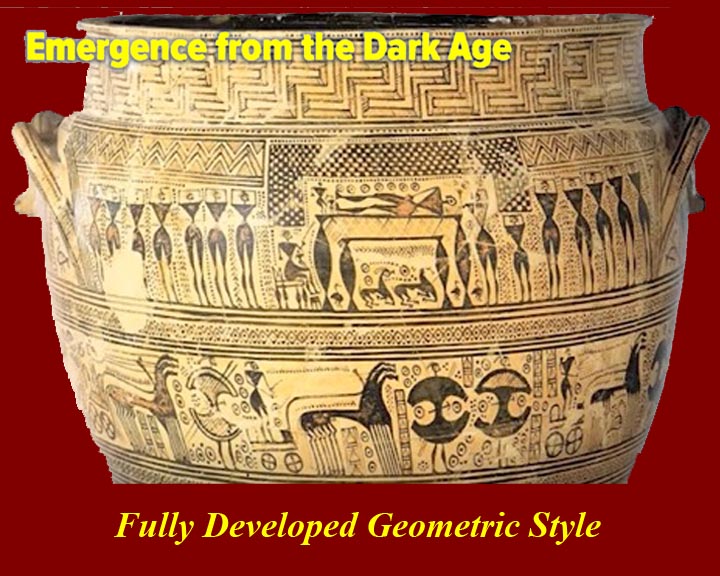
Geometric art is a phase of Greek art, characterized largely
by geometric motifs in vase painting, that flourished
towards the end of the Greek Dark Ages, circa 900 BC to 700
BC. Its center was in Athens, and it was diffused amongst
the trading cities of the Aegean.
See https://en.wikipedia.org/wiki/Geometric_art.
Iron Technology
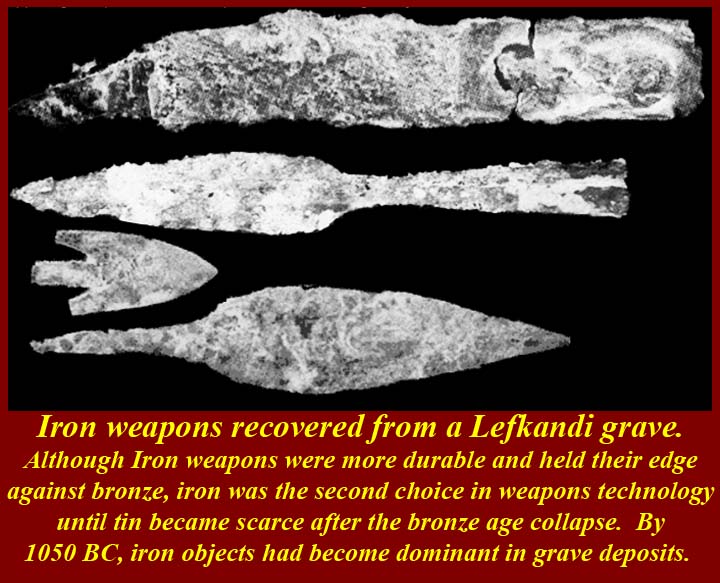
Modern archaeological evidence identifies the start of iron
production as taking place in Anatolia around 1200 BC,
though some contemporary archaeological evidence points to
earlier dates. (There certainly was worked meteoric
iron before 1200 BC.) 1200 was about the same time
that Mycenaeans were colonizing Wastern Anatolia. It
appears that that mainland Greeks knew about iron making,
but continued to use bronze as long as tin and copper were
easily available. When those metals became scarce due
to the breakdown of international trade at the end of the
bronze age, iron came into use even though smelting that
metal was much more difficult. It did help that iron
ores were available in Greece; iron, although harder to
make, was actually cheaper and less prestigious.
See https://en.wikipedia.org/wiki/Iron_Age.
Real and imagined causes of the Dark Age
Sea peoples
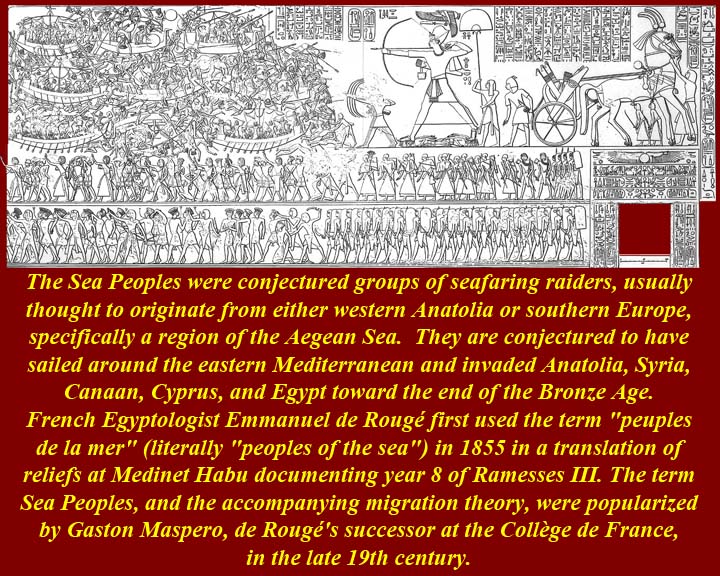
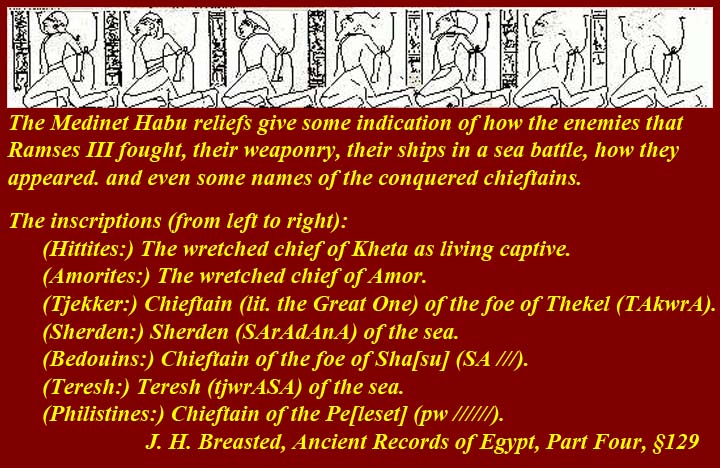
The idea of Sea Peoples arose after translation in a french
translation of Egyptian reliefs of Ramses III at Medinet
Habu in 1855. The relief mentioned by name a number
groups conquered, captured, and settled in Egypt by
Ramses. The translator, French Egyptologist Vicomte
Olivier-Charles-Camille-Emmanuel de Rouge, called them all
"Sea People" even though, as it turned out, most of them
have now been identified as migrants who arrived by land and
even though the hieroglyphs made no mention of Sea People.
See https://en.wikipedia.org/wiki/Sea_Peoples
and http://www.salimbeti.com/micenei/sea.htm
and http://www.reshafim.org.il/ad/egypt/sea_peoples.htm.
There were, in fact, refugees/migrants/colonists/invaders
who came by sea to various Mediterranean ports -- Mycenaean
Ionians -- but there's more than an even chance that, rather
than causing the collapse of the Bronze Age centers, they
moved into the vacuum just as the Dorians had done in
mainland Greece. There may have been some fighting in
some places, but archeological evidence suggests that in
most places the Mycenaean/Ionian new arrivals just mixed
with the local villagers as did new arrivals from other
migrating groups. In many places where
Mycenaeans/Ionians settled, archeological investigations
have revealed a melding of styles of pottery, art, and
architecture.
Earthquakes
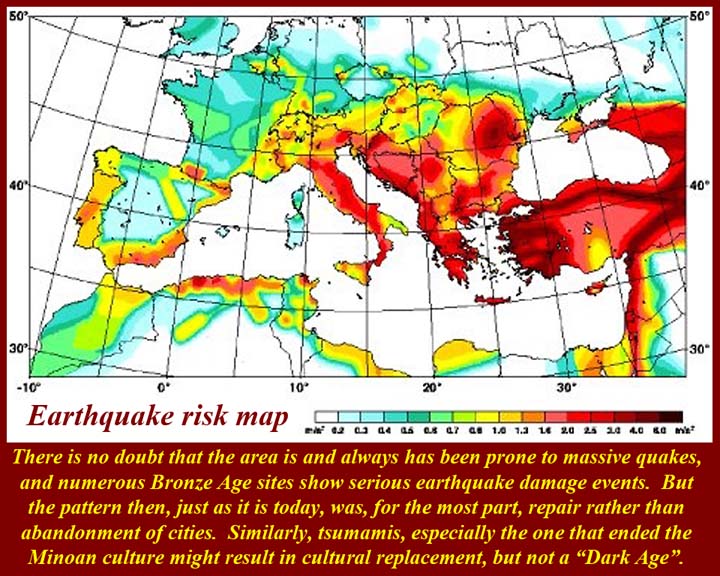
The pattern after earthquakes (and tsunamis) has
always been to rebuild rather than abandon. It is
true that cultural change and even replacement might
occur, but seldom were sites (and certainly not all
sites) abandoned.
Globalization and systems collapse
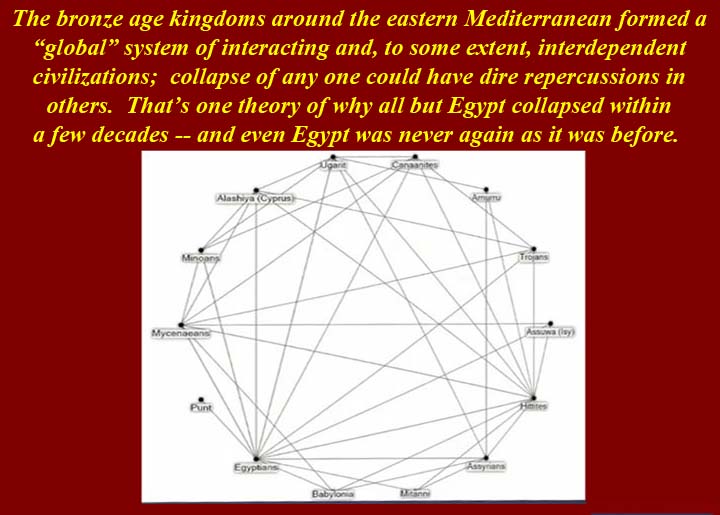
Interconnection, domino effect, overpopulation, over use of
resources, tyranny leading to internal revolts, etc.
have all been seen as leading to "systems collapse," a
modern term that just means everything fell apart as a
result of there not being enough glue to hold things
together. But "Everything fell apart just because it
couldn't stay together" is circular reasoning, as accurate
as that might be.
Climate change!
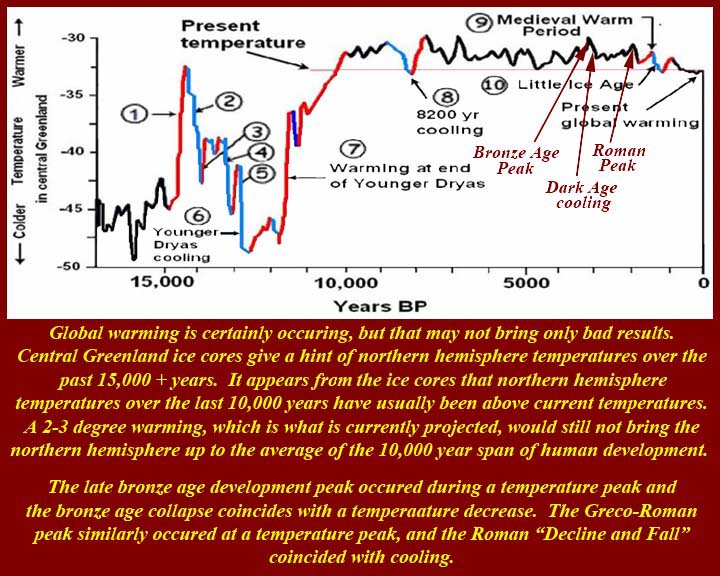
It was inevitable that recent research would
point to climate change. But it's also a cogent
argument. Paleometeorologists love to make graphs and
charts, and this one seems to indicate that a cold snap
lasting many years could have decreased agricultural
productivity to the point that large urban populations could
not be supported (just a it is known to have happened at the
end of the Medieval Warm Period). Earlier drought
theories are subsumed in this theory. Look at the
chart and decide for yourself.
See http://www.historicalclimatology.com/blog/-climate-crisis-and-causality-at-the-end-of-the-bronze-age
and
http://www.academia.edu/1411970/The_Influence_of_Climatic_Change_on_the_Late_Bronze_Age_Collapse_and_the_Greek_Dark_Ages







































